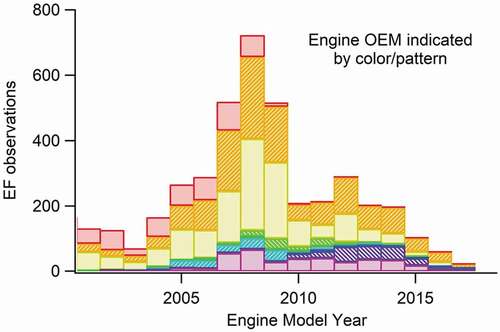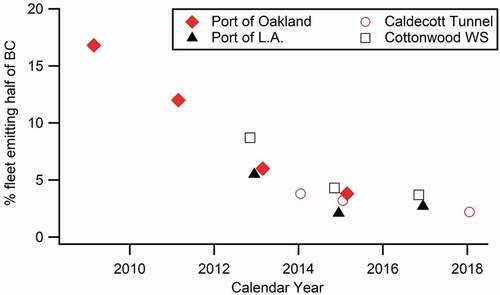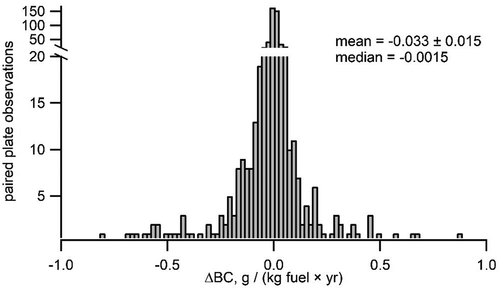 ?Mathematical formulae have been encoded as MathML and are displayed in this HTML version using MathJax in order to improve their display. Uncheck the box to turn MathJax off. This feature requires Javascript. Click on a formula to zoom.
?Mathematical formulae have been encoded as MathML and are displayed in this HTML version using MathJax in order to improve their display. Uncheck the box to turn MathJax off. This feature requires Javascript. Click on a formula to zoom.ABSTRACT
Over the past decade, efforts to reduce emissions of particulate matter (PM) and oxides of nitrogen (NO + NO2, or NOx) from heavy-duty diesel vehicles (HDDVs) have led to the widespread adoption of both Diesel Particulate Filters (DPFs) to control PM and Selective Catalytic Reduction (SCR) to control NOx. We evaluated the performance of DPFs and SCR with 13,327 real-world fuel-based Black Carbon (BC) and NOx emission factors from 9,167 unique heavy-duty vehicles (primarily HDDVs) measured at four sites in California (two ports, two highways) from 2011 to 2018. BC emission factors have decreased by 90% during the past decade. At the same time, BC distributions have become increasingly skewed toward “high-emitters” – e.g., the portion of the HDDV fleet responsible for half of all BC emissions has decreased from ~16% to ~3%. NOx emission factors have also decreased over the past decade, but by only 31%. They remain roughly five times greater than in-use thresholds.We examined changes in BC and NOx emissions with engine age. BC emissions from DPF-only trucks decreased slightly but insignificantly, by 6 ± 15 mg/kg fuel per year, while for DPF+SCR trucks they increased by 5 ± 3. These changes are less than 5% of in-use thresholds. The annual increase in NOx emissions with age was much greater: 1.44 ± 0.28 g/kg for older SCR trucks without on-board diagnostic (OBD) capabilities and 0.48 ± 0.35 for newer trucks with OBD, roughly 20– 50% of in-use thresholds. Paired t-tests on the over 600 vehicles that were observed in multiple campaigns were consistent with these results. Observed changes in BC emissions with age were best fit with a “gross emitter” model assuming an annual DPF failure rate of 0.83 ± 0.01% for DPF-only trucks and 0.56 ± 0.01% for DPF+SCR trucks.Implications: These observations of real-world HDV emission factors have several major implications for regulatory efforts to reduce them. The increasing importance of a relatively small number of high BC emitters suggests that widespread sampling of the on-road fleet will be necessary to identify these vehicles. On the other hand, the much more ubiquitous deterioration in NOx control measures may be better addressed by incorporating on-board diagnostic systems, with telematic data transfer when possible, into inspection and maintenance programs. These NOx observations also highlight the need for strengthening heavy-duty SCR durability demonstration requirements.
Introduction
Heavy-duty diesel vehicles (HDDVs) emit significant amounts of the diesel particulate matter (PM) and oxides of nitrogen (NOx = nitric oxide + nitrogen dioxide, or NO + NO2) in the atmosphere. In the state of California, on-road vehicles emit 51% of diesel PM (CARB, Citation2017a), and HDDVs emit 73% of on-road NOx and 37% of all anthropogenic NOx (CARB, Citation2017b). Over the past several decades, policies attempting to reduce these emissions have been enacted, including the tightening of certification standards and the implementation of new in-use requirements. These policies have spurred the widespread adoption by HDDVs of Diesel Particulate Filters (DPFs) to control PM emissions, and Selective Catalytic Reduction (SCR) to control NOx emissions.
PM emitted by HDDVs is a toxic air contaminant (CARB, Citation1998) and a carcinogen (Benbrahim-Tallaa et al. Citation2012). California’s Diesel Risk Reduction Plan, adopted in 2000, called for a 75% reduction in diesel PM by the year 2010 and an 85% reduction by 2020 (CARB, Citation2000). There have been two primary regulatory efforts made toward these goals. The first was the tightening of on-road heavy-duty diesel engine (HDDE) PM certification standards from 100 to 10 mg/bhp·hr beginning with engine model year (EMY) 2007. The second has been the requirement that existing HDDEs incorporate the Best Available Control Technology (42 U.S.C. §7479(3)) for PM. This is equivalent to a Level 3 Verified Diesel Emission Control Strategy (13 C.C.R. §2700-2710), which (as with new engines) requires PM emission to be limited to 10 mg/bhp·hr. This requirement, which essentially requires that all existing HDDVs be retrofit with DPFs, was a critical feature of both CARB’s Drayage Truck Regulation and Truck and Bus Rule, and has reduced diesel PM emissions much more quickly than natural fleet turnover alone would have allowed. Both the tightening of certification standards for new HDDEs and the retrofit requirements for existing HDDEs are necessary for California to meet the goals set forth in the Diesel Risk Reduction Plan.
Large areas of the state of California, including the San Joaquin Valley and the South Coast Air Basin, are currently not in attainment of National Ambient Air Quality Standards (NAAQS) for PM2.5 (particles with diameters less than 2.5 μm) and ozone. Particularly in the San Joaquin Valley, nitrate (which is formed by atmospheric oxidation of NOx) often dominates PM composition, especially when ambient PM concentrations are high (Chen et al. Citation2014). NOx is also an important precursor for ozone. In response to both PM2.5 and ozone non-attainment, the HDDE certification standard for NOx was tightened from 2.4 to 0.2 g/bhp·hr beginning with EMY 2010. This tightening has prompted the widespread adoption of selective catalytic reduction (SCR) systems, which reduce NOx to N2, on HDDVs. However, many studies have found that in-use (or “real-world”) NOx emissions are much greater than what would be expected based on certification standards (Bishop et al., Citation2013; Haugen and Bishop Citation2018; Kolz, Kittleson, and Northrop Citation2016; Misra et al. Citation2013; Velders, Geilenkirchen, and De Lange Citation2011; Yoon et al. Citation2017).
Here we analyze a relatively large set (n = 13,327) of real-world heavy-duty vehicle fuel-based emission factors (EFs). These observations were made at four California sites from 2009 through 2018. Results from these campaigns were matched to license plates to obtain vehicle information, and have been published previously (Haugen and Bishop Citation2017, Citation2018; Preble et al. Citation2018, Citation2015). Some calculations also include results from one of the field sites, the Port of Oakland, in 2009 that were not matched to license plates (Dallmann, Harley, and Kirchstetter Citation2011). This work advances those previous publications by analyzing the combined dataset from all 12 campaigns and investigating the change in emissions as a function of HDDV age. The change in emissions over time is examined both at the fleet level and, with a paired t-test, at the individual vehicle level for all vehicles observed in multiple years.
One of the primary goals of this work was to better understand how emissions change during a vehicle’s life. As has been noted in previous publications, real-world Black Carbon (BC) emissions from HDDVs are dominated by a relatively small number of trucks. Some of these high-emitters have DPFs, but these DPFs have apparently failed. To help describe the relationship between BC emissions and age at the fleet level (i.e., incorporating all observations), we use a “gross emitter” model. It assumes emissions are constant until a failure of the aftertreatment system occurs, at which point emissions step to a new, higher constant value. This model is similar to the one described in Pitchford and Johnson (Citation1993), and fitting it to observation yields, among other parameters, an annual failure rate. We contrast this to a “uniform” model, in which emissions controls are assumed to deteriorate, and thus emissions increase steadily (each year) with vehicle age. This model generally better fits NOx observations and allows us to derive an annual deterioration rate. This deterioration rate is an analog to the failure rate used in the gross emitter model. Finally, we isolate HDDVs that were observed in multiple campaigns (631 for BC observations, 587 for NOx), to investigate changes in emissions with age at the individual vehicle level.
Materials and methods
Summary of field campaigns
Emissions from heavy-duty vehicles (HDVs) were measured at four sites in California, including two ports with predominantly drayage fleets and two highway locations with predominantly long-haul fleets. The port locations were the Port of Los Angeles and the Port of Oakland, and the long-haul locations were the Cottonwood Weigh Station and the Caldecott Tunnel (). Only one lane was sampled at each site, but the lane with the heaviest HDV traffic was generally selected, typically resulting in at least half of all trucks being sampled. A total of 13,327 valid observations were made during three campaigns at each of these four sites (). At the Port of Los Angeles and Cottonwood weigh stations in 2017, opacity testing based on the SAE J1667 protocol (SAE, Citation1996) was also conducted on a voluntary basis on a subset of the trucks whose emission factors were observed. During a “snap idle” in which the accelerator is depressed while the truck is stationary, these tests measure the opacity of tailpipe emissions, ranging from 0% to 100%. An IR camera was also used to estimate exhaust pipe temperature at these two sites.
Figure 1. (a) Map of field sites in California, and (b) inset map of the United States. The field sites include two ports (Oakland and Los Angeles), and two long-haul sites (the Cottonwood Weigh Station and the Caldecott Tunnel)
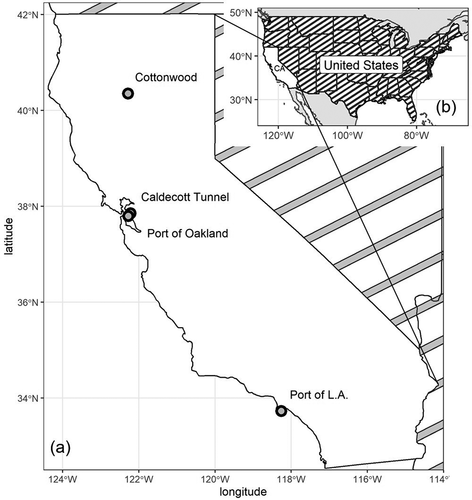
Table 1. The number of observations made during each campaign
Overall, in the twelve campaigns at these four sites, there were a total of 9,167 unique license plates with valid emission observations that were matched to registration databases. These databases include the California Department of Motor Vehicles (DMV), the International Registration Plan, and CARB databases such as the Truck Regulation Upload Compliance and Reporting System (TRUCRS) and the Drayage Truck Regulation Registration.
Of these 9,167 unique plates, 8,447 (92.1%) were observed in only one campaign, 659 (7.2%) were observed in two campaigns, 60 (0.7%) were observed in three, and one was observed in four. Of the plates observed in three campaigns, 43 (72%) were seen in all three Port of LA campaigns, 6 (10%) were observed in all three Cottonwood campaigns, 1 (1%) in all three Port of Oakland campaigns, and the remaining 10 (17%) at more than one site. Of the plates observed in only two campaigns, 34% were seen twice at the Port of LA, 13% were seen twice at Cottonwood, 23% were seen twice at the Port of Oakland, 23% were seen twice at Caldecott, and the remaining 7% were seen at more than one site. Generally, it is preferable to have multiple measurements at the same site, since duty cycles and sampling methodology will be more similar and thus emission factors more comparable.
HDV emission factors were measured by two different methods. At Cottonwood and the Port of L.A., a 50ʹ-long tent was used, which partially blocks cross-wind flow (Bishop et al. Citation2015; Haugen and Bishop Citation2017, Citation2018). Perforated tubing running horizontally along the length of the upper portion of the tent acts as an inlet to the analytical instrumentation housed in an adjacent mobile laboratory. At the Caldecott Tunnel and the Port of Oakland, samples were collected through a vertical duct lowered from an overpass to an instrumented van parked on the overpass, which allows for sampling of HDVs traveling at higher speeds, but for a shorter duration (Preble et al. Citation2018, Citation2015). Due to the relatively short sampling times (~10 sec for the former system and ~3 sec for the latter), these observations should be considered “snapshots” instead of integrated full drive cycle values. For example, the highest observed emission factors are greater than what might be expected for average “engine-out” emissions. These transient values, however, would not likely be maintained over longer periods.
The duty cycles also varied among and within sites. Vehicle speed through the tent was typically 5 to 10 miles per hour (MPH) along a relatively flat roadway, but the addition of a speed bump at the Port of L.A. and additional sampling equipment at both tent sites caused vehicle speeds to be lower in 2017. In contrast, the overpass sampling occurred either when vehicles were traveling ~50 MPH up a ~4% road grade at the Caldecott Tunnel, or ~35 MPH at the Port of Oakland. Although these systems sample vehicles in different ways, they use similar instrumentation (detection limits, accuracy, etc.) to measure emissions. It is therefore likely that these differences in drive cycles, and potentially also differences in plume capture techniques and timing, are bigger causes of inter-site variability than differences in analytical techniques.
Distribution of fleet observations
The entire set of observations was grouped by engine Original Equipment Manufacturer (OEM) and EMY. Engine information was only available for approximately half (5,163) of the recorded license plates, largely because the DMV registration records only contain chassis (not engine) information. Other databases such as TRUCRS and the Drayage Truck Registry, both maintained by CARB, contain engine information and were used to match as many observed plates as possible. For example, over 5,000 unique plates were matched in the TRUCRS database ().
Figure 2. Distribution of the nine most prevalent Engine OEMs (indicated by color), from (a) the TRUCRS database and (b) real-world observations
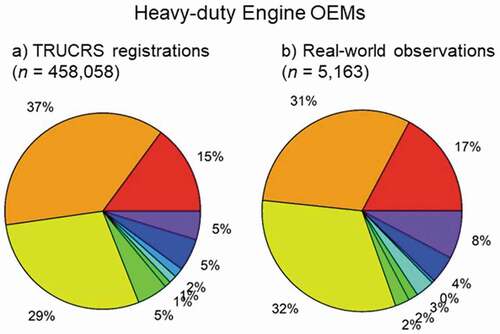
compares the distribution of engine OEMs in the TRUCRS database to those from the real-world observations that were matched to this database. The sample of HDVs whose EFs were quantified is representative of the TRUCRS fleet. Some OEMs were slightly under- or over-represented, but generally, the OEMs comprised a very similar portion of each set. The TRUCRS registration data is self-reported, and therefore likely contains some misidentified engine and/or chassis OEMs. Also, larger fleets and those requesting Truck and Bus Rule exemptions are likely to be over-represented in TRUCRS.
indicates the number of real-world observations of each Engine OEM, broken down by engine model year. Note that, largely because trucks with downward-oriented exhaust were not sampled, there are fewer trucks with more recent model year engines. The nine most prevalent OEMs are included. A downturn in the number of HDVs is seen for EMYs during the Great Recession (in 2010), which can be attributed to the weakened economy during this period. Similar MY patterns have been observed for light-duty fleets (Bishop and Stedman Citation2014), although if anything, the variation in HDVs is more pronounced.
Observations
Overall emission reduction trends
Over the past decade, emissions of BC from heavy-duty vehicles at these sites have decreased dramatically (). As discussed previously, California’s Diesel Risk Reduction Plan called for a 75% reduction in diesel PM emissions from 2000 to 2010 and an 85% reduction from 2000 to 2020. A linear regression of all BC measurements vs. sample date () indicates that diesel PM decreased by 90% between 2009 and 2018, suggesting that, even in the absence of data from before 2009, the state DRRP goal for the 2020 on-road fleet was met ahead of schedule. On-road fleet average BC emissions are now below the rough equivalent of the PM certification standard of 10 mg/bhp-hr, or 70 mg/kg fuel assuming 7 bhp-hr in 1 kg of fuel (Burgard et al. Citation2006).
Figure 4. Fuel-based emission factors (EFs) for (a) BC and (b) NOx vs. year of observation. EFs are grouped by campaign (boxes for 25th/75th percentiles, whiskers 5th/95th, and symbols are means). Linear regressions w/95% confidence intervals are also shown, as are the in-use (Not-To-Exceed) thresholds
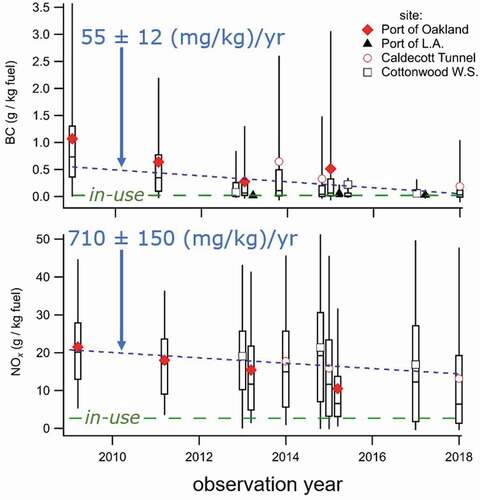
NOx emissions have also decreased during the past decade, although the relative decrease is much lower than for BC (). This is likely due at least in part to the earlier phase-in of tighter certification standards and retrofit requirements for PM relative to NOx. The decline of 73 mg NOx/(kg-yr) is equivalent to a decrease of 31% over the decade (much smaller than the 90% reduction in BC). Note that NOx EFs from the Port of Los Angeles are not included in this calculation, due to presumed poor performance of SCRs due to lower exhaust temperatures at this site (discussed in section 3.3). Mean emission factors are still roughly five times greater than expectations based on the in-use threshold (0.45 g/bhp-hr), although some vehicles use a higher in-use threshold (e.g., 0.75 g/bhp-hr) based on Family Emissions Limit (FEL) standards. As discussed earlier, high real-world NOx emissions have been reported by many other studies, likely due to differences between real-world and standard dynamometer duty cycles.
HDVs were assigned an aftertreatment category when possible, and this list included “none” (no DPF nor SCR), “retrofit DPF”, “DPF” (i.e., OEM DPF), and “DPF + SCR”. This was based on engine model year (typically obtained from CARB’S TRUCRS database), retrofit and exemption status as reported to TRUCRS, and chassis model year (typically obtained from DMV registration data). When engine MY was not available, chassis model year minus one was used to assign aftertreatment category. This category was left as “unknown” when no chassis or engine MY was available (i.e., no matches in the DMV or other databases), when the chassis MY was 2010 (as this could be an engine MY 2009 or 2010), or when the chassis MY was less than 2008 but retrofit status was not available from TRUCRS.
As expected, both median and mean BC EFs decreased monotonically as aftertreatment progressed (from None to retrofit DPF to OEM DPF to OEM DPF + SCR, see ). However, BC distributions also became more skewed with successive generations of aftertreatment (Figure S1). This suggests that, while DPFs broadly speaking have been very effective at reducing PM emissions from HDVs, they are not universally effective, and increased efforts are necessary to identify and repair the relatively small number of HDVs responsible for most of the BC emissions. Figure S3 also indicates that emissions from these high-emitting trucks do not decrease monotonically with aftertreatment progression. High-emitting DPF-equipped trucks have EFs very similar to high-emitting trucks with no filter.
Table 2. Summary of EFs, grouped by aftertreatment category
BC emissions
indicates that DPFs are performing relatively well in their first decade on the roadways of California. This is even more clear when the BC emissions of HDDVs with DPFs are compared to those from trucks without filters (Figs. S2 and S3). To better gauge the performance of DPFs over their lifetime, we regressed BC emission factors onto vehicle age instead of calendar year (as in ). All data were included in these regressions – i.e., no outliers or negative values were omitted. displays these regressions for each field site, and the combined dataset. Results are given separately for DPF-only () and DPF+SCR () trucks. Although an increase in BC was seen for each aftertreatment type at each site, most of these increases were both small in magnitude and lacked statistical significance. The overall trend for DPF-only HDDVs is negative but not significantly different from zero (−6 ± 15 mg/kg-yr, all reported uncertainties are 2σ or 95% confidence). The trend for the latter is positive (5 ± 3 mg/kg-yr). The absolute value of both these trends is very small, however, equivalent to less than 5% of in-use thresholds. (Note that, for clarity, these overall trends are not displayed in – only trends from individual sites are depicted).
Figure 5. Fuel-based BC emissions by DPF-equipped HDDVs as a function of integer vehicle age (i.e., calendar year minus engine model year). Box/whisker colors and outlier symbols indicate the four field sites. Boxes indicate 25th and 75th percentiles (i.e., interquartile range, or IQR), and outliers are points greater than 1.5 × IQR from the box edges. Linear regressions are given with 95% C.I.s for each of the four individual sites. Included are HDDVs equipped with (a) OEM (not retrofit) DPFs, typically EMY 2007– 09, and (b) DPF + SCR, typically EMY 2010 +
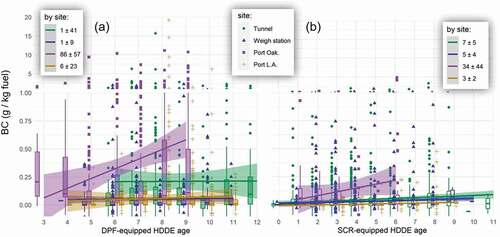
Each site had a positive BC vs. age slope for each aftertreatment group, and this increase was significant with 95% confidence at three of the eight aftertreatment-site combinations. All trends were less than 8 mg BC/(kg-yr), except at the Port of Oakland. Also, note that the overall BC vs. age trend was negative. This may be because the Port of Oakland had the highest BC emissions, but this fleet was on average younger than at the other three sites, contributing to a slight downward slope moving toward the older vehicles. Measurements began at this site two to three years earlier than the three other sites. It thus has more younger DPF-only trucks, and fewer older DPF-only and DPF+SCR trucks, than the other sites.
includes all BC observations, grouped by age, ranked from highest to lowest, from HDDVs with DPFs but no SCRs. Most of the observations are near expectations based on the in-use threshold. Only about 5% of BC emission factors are clearly (severalfold) above this threshold. Furthermore, this percentage did not show any clear trend with vehicle age, suggesting that most individual DPFs are relatively durable.
Figure 6. (a) BC and (b) NOx emission factors, grouped by age (in two-year bins indicated by color and symbol), ranked from highest to lowest. Note the log scale on the x-axis, which ranks the emissions on a percentile basis
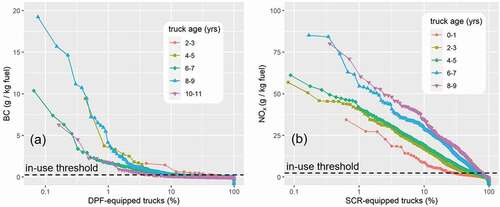
The most pronounced trend in HDV BC emissions over the past decade, other than their overall reduction, is the emergence of so-called “high-emitters.” In other words, an increasing share of overall BC is being emitted by a smaller fraction of on-road HDVs. At the time of the first widespread appearance of diesel particulate filters (DPFs), around 2008, half of all HDV BC was emitted by approximately one-sixth (~16%) of the fleet. A decade later, half of all BC was emitted by only one-thirtieth (<4%) of the fleet (). HDVs with BC emission factors of ~1 g/kg fuel or higher, which is over an order of magnitude above expectations based on the current certification standard (0.07 g/kg fuel), were seen from all aftertreatment categories and at all locations (Figure S3).
The addition of SCR to DPFs has reduced PM emissions both generally and from high-emitters. This is likely due to a change in engine calibration, partly associated with a reduction of Exhaust Gas Recirculation (an earlier NOx control strategy) with SCR adoption (Rudrabhate and Chaitanya Citation2017). This change to leaner combustion conditions tends to decrease engine-out PM. It may also be due to a shift from active to passive regeneration of DPFs with the addition of SCR, which may mitigate deterioration of DPFs. Regardless of the specific mechanism(s), this underscores the importance of enforcing the state of California’s Truck and Bus Rule provision that all HDVs be equipped with 2010-compliant engines by 2023. Even with DPF + SCR, however, some trucks still emit PM at nearly engine-out levels. BC emissions by 14% of these HDVs exceeded the approximate certification standard (assumed to be 70 mg/kg fuel), and 5% of these had BC EFs greater than 200 mg/kg fuel. This highlights the need for an inspection and maintenance program to identify and repair these high-emitting vehicles.
NOx emissions
In contrast to DPFs, SCRs have not reduced NOx emissions to levels expected based on in-use compliance thresholds () under the Not-to-Exceed (NTE) regulation. This threshold typically applies to less than a third of all NOx emissions and about a tenth of all engine operation time (Dixit et al. Citation2017; Tan et al. Citation2019), however, as the NTE limits only apply under certain operating conditions, e.g., when exhaust temperature is below 250°C, or when engine power or torque is below certain thresholds. There are many possible reasons for this lower-than-expected NOx reduction, including low SCR temperature (e.g., Misra et al. Citation2013), insufficient dosing of diesel exhaust fluid (Opitz et al. Citation2015), poor maintenance/tampering (e.g., Belser Citation2020), and catalyst deterioration (Schmeig et al. Citation2012).
NOx emissions, in decreasing order, are shown for each age (binned by 2 years) in for all SCR-equipped HDDVs. In sharp contrast to BC EFs (), a consistent increase in NOx emissions with vehicle age is apparent and can be seen across the entire fleet (from the dirtiest to the cleanest trucks). Real-world NOx emission measurement should be continued over the next decade to determine if this broad increase in NOx emissions with vehicle age continues. Similar ranked plots grouped by aftertreatment category are also given (Figures S4 and S5).
As with BC, we regressed NOx emissions onto SCR-equipped vehicle age for each site, and for the overall dataset (). No data was omitted from these regressions. Also, as with BC, we separated SCR-equipped HDDVs into two groups: those without on-board diagnostics (OBD), and those with OBD ( and , respectively). These groups are defined by EMY 2010– 12 and EMY 2013– 15.
Figure 8. Fuel-based NOx emissions by SCR-equipped HDDVs as a function of engine age (i.e., calendar year minus model year). Box colors and outlier symbols indicate the four field sites. Boxes indicate 25th and 75th percentiles (i.e., interquartile range, or IQR), and outliers are points greater than 1.5 × IQR from the box edges. Linear regressions are given with 95% confidence intervals. (a) EMY 2010–12 trucks, assumed to have SCR but not OBD. (b) EMY 2013–15 trucks, assumed to have SCR and OBD
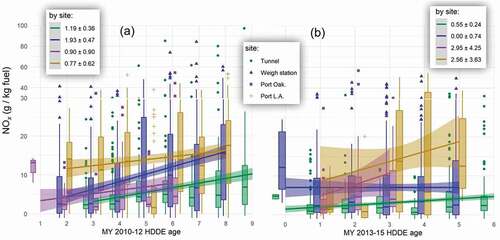
The overall annual increase in NOx from OBD trucks was 0.48 ± 0.35 g/kg fuel (), about two-thirds lower than the 1.44 ± 0.27 increase seen for trucks without OBD (). Unlike the annual BC increases, which amounted to less than 5% of the NTE PM threshold, these annual NOx increases represent about one-quarter and three-quarters of the fuel-equivalent NTE NOx threshold of ~2 g/kg. Of the eight groups (two model year groups at each of four sites), one had no change in NOx emissions with age, three showed an increase that was not significant with 95% confidence, and four had a significant increase. A significant increase in NOx emissions from the trucks without OBD was observed at each of the four field sites, although this increase was statistically significant for OBD trucks only at the tunnel site.
SCR performance at the Port of L.A., where trucks leaving the port were sampled, was poor compared to the other sites (including the Port of Oakland). Estimates of exhaust pipe temperature using a roadside infrared camera (Bishop et al., Citation2013) were lower at the Port of L.A. than at Cottonwood, and Cottonwood had a higher percentage of trucks with exhaust pipe temperatures above 120°C degrees than at the Port in both 2013 (17% vs. 3%) and 2015 (20% compared to 3%, Bishop and Haugen Citation2018). Furthermore, trucks in Oakland were sampled headed toward the Port at roughly 35 MPH, and trucks traveling up a 4% grade at approximately 50 MPH were sampled at the Caldecott Tunnel. This 4% road grade is equivalent to an acceleration of approximately 0.4 m/s2 (or 0.9 MPH/s). The Port of L.A. campaigns, on the other hand, likely sampled trucks with lower engine output and thus lower SCR temperatures than at the other sites.
Predicting changes in BC emissions with HDDV age
Changes in BC emissions with HDDV age were investigated with a “gross emitter” model, similar to the one described in Pitchford and Johnson (Citation1993). We used this model to determine the annual net failure rate (aF) that best fit observed BC emission factors as a function of vehicle age. This model can be compared to a “uniform” model which assumes that emissions change linearly with age. Both models are described in detail in the SI (Figure S6, Table S1).
(and Table S4) depicts the best-fit parameters for the gross emitter model for each aftertreatment type. BC from gross emitters () ranged from around 1 to 3 g BC/kg fuel. This is roughly equivalent to several hundred mg of PM per bhp-hr, which is broadly consistent with expectations for “engine-out” PM. Such values are expected for tailpipe PM if the DPF has undergone a catastrophic failure (e.g., due to cracking). Note that this definition of “failure”, producing engine-out levels at the tailpipe, is relatively conservative – other investigators have used the term “failure” to describe tailpipe emissions higher than certification and/or in-use standards, but still much lower than engine-out levels (e.g., Preble et al. Citation2015).
Figure 9. (a) Gross emitter and (b) Uniform model parameters that best fit the observed BC emission factors, grouped by aftertreatment type. Error bars depict 95% confidence intervals
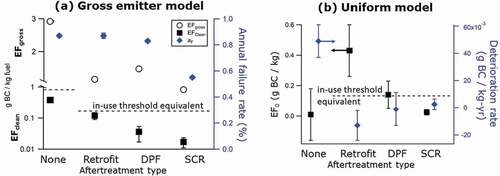
BC emissions from both gross emitters and clean vehicles () decreased when SCR was added, although the certification standard for PM is identical for DPF and DPF + SCR HDDVs. This decrease was well beyond the 95% confidence intervals for
. This likely reflects changes in engine tuning associated with SCR. Specifically, HDVs without SCR rely primarily on exhaust gas recirculation to control NOx, which leads to higher engine-out PM emissions. Thus, when these DPFs do fail, they emit greater amounts of BC.
The annual DPF failure rates predicted by the gross emitter model ranged from 0.56% for SCR-equipped HDVs to 0.88% for those with retrofit DPFs (). The sharp decrease in the DPF failure rate with the addition of SCR is likely due in part to the higher engine-out PM levels from DPF-only vehicles, which may increase wear and tear on the DPF. Also, DPF-only trucks may require more frequent active regeneration of their filters, which increases their temperature to around 500 ⁰C to burn off accumulated PM (Ruehl et al. Citation2018; Yamada, Inomata, and Tanimoto Citation2017). Trucks with SCR generally can more efficiently utilize passive regeneration (with no temperature increase), due to higher engine-out NO2 levels (NO2 can oxidize soot) and improvements in DPF technology. Thus, the wear and tear associated with active regeneration may be partly responsible for the higher failure rates for DPFs without SCR.
A previous analysis of real-world HDDV SAE J1667 opacity readings also found that DPF failure rates increase with odometer readings, although these results were not based on vehicle age (CARB, Citation2018). To compare these datasets, a conversion of 40,000 annual miles was used based on EMFAC averages for HDDVs. The percent of HDDVs with opacity greater than 3% increased by 1.1% for every 40,000 miles traveled for MY 2007–09 engines, and by 0.22%/40,000 miles for MY 2010+ engines. Thus, despite the different definitions of “failure” used in these studies, the annual failure rates were of similar magnitude, and both studies found a lower DPF failure rate when coupled with SCR (although this difference was more pronounced in the opacity study).
The uniform model () was similar to the gross emitter model in that the best fit emission factors for both new vehicles (EF0) and clean vehicles () were similar to expectations based on certification standards. Consistent with the regression analysis in Section 3.2, however, the BC deterioration rates for both OEM-DPF and DPF-SCR HDDVs were not significantly different from zero.
Repeat measurements of individual trucks
One of the most useful features of this combined dataset is the relatively large number of trucks (over 600) that were observed in more than one campaign. Often trucks were observed multiple times within a single campaign, but in these cases, campaign averages for individual trucks were calculated.
Annual changes in BC emissions
Valid BC emission factors were observed in two campaigns for a total of 555 unique license plates, and three campaigns for an additional 39 plates. The distribution of the annual changes in BC emissions for these vehicles is shown in . The average change in BC emission for HDVs observed in two separate campaigns was −33 ± 15 mg/(kg-yr). Quoted uncertainty is the standard error of the mean. The median was −1.5 mg/kg fuel. Consistent with a median value close to zero, just under half (49.4%) of these annual changes were positive.
A paired t-test was performed on the 631 repeated BC measurement to determine if they were significantly different. The p-value was 0.066 (), indicating close to, but less than, 95% confidence that the BC emissions from these vehicles had changed from the first observation to the second. Thus, while a relatively small number of sampled DPFs are not operating properly (~10% of EMY 2007–2009 and ~5% of EMY 2010+), their emissions were not changing substantially over time in this sample set. This is consistent with the negative slope of the regression of all BC EFs onto HDDV age discussed above. Both of these trends may reflect retirement or reassignment of high-emitting vehicles, as opposed to actual decreases in emissions from individual trucks. They could potentially also reflect improvements in DPF efficiency with time, e.g., improved collection efficiency with the development of a “soot cake” (Bensaid et al. Citation2009).
Table 3. Results of paired t-test for HDVs with BC and NOx measured in multiple field campaigns
Average BC emissions decreased for all assumed aftertreatment categories, although this decrease was not statistically significant (p < .05) for any of them (, Figure S8). Note that identification of HDDVs as “retrofit DPF” is based on self-reported registration data in TRUCRS, and it is quite possible that some of the HDVs classified as “none” have been retrofit with DPFs. This might explain some of the observed decrease in BC emission for the HDVs classified as “none.”
Table 4. Paired BC sample statistics, separated by assumed aftertreatment category. Quoted uncertainty in mean values is the standard error
Based on this categorization by aftertreatment, it can be inferred that at least some of the overall observed slight reduction in BC emissions from HDVs measured in more than one campaign was due to trucks without DPFs. This strengthens the conclusion that BC emissions from real-world DPFs are, on average, not changing. Note that variability is high for the change in BC, especially for OEM DPFs. Even though these represent the most prevalent aftertreatment type, the p-value of 0.63 is very high (), and the standard error of the mean is greater than its absolute value. Even with all this variability, the median change in BC emissions was less than 1 mg/(kg-yr).
In addition to categorizing the change in BC emissions by aftertreatment type, we also performed these paired tests separately based on years between the observations (Figure S9, Table S4). Unlike the results broken down by aftertreatment type, no clear trend was seen in the results as a function of time between observations.
Annual changes in NOx emissions
Valid NOx emission factors for a total of 587 unique VINs were observed in two separate campaigns, and in three campaigns for an additional 25 VINs. Those HDVs observed in three campaigns were split into two pairs, such that the time between each sampling campaign was maximized. For example, if an HDV was observed in 2013, 2015, and 2017, two paired samples were used: 2013–2015, and 2013–2017. This provides an additional 25 pairs, for a total of 637 pairs. The change in NOx for each paired VIN was calculated. The distribution of the annual changes in NOx emissions is shown in . Well over half (60.2%) of these annual changes were positive, and the mean of 1.81 g/(kg-yr), was nearly equal to expectations based on the current in-use threshold (2 g/kg fuel, assuming ~7 bhp·hr/kg fuel). In other words, deterioration of NOx control systems (e.g., SCR) is a widespread issue. This deterioration could be largely responsible for the well-known “high in-use NOx” problem whereby on-road emissions are much higher than those expected based on both certification standards and in-use thresholds (Bishop et al., Citation2013; Haugen and Bishop Citation2018; Kolz, Kittleson, and Northrop Citation2016; Misra et al. Citation2013; Velders, Geilenkirchen, and De Lange Citation2011; Yoon et al. Citation2017), although real-world driving patterns are also likely responsible.
Figure 11. Annual change in NOx emissions from individual trucks measured in more than one field campaign
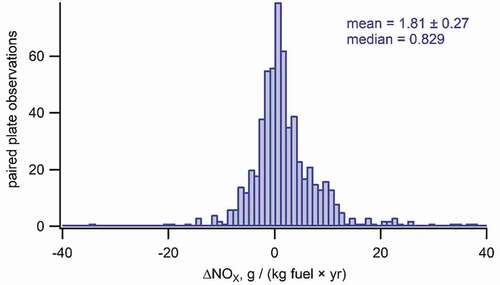
A paired t-test was performed on the 637 repeat observations to determine if they were significantly different. The p-value was 3 × 10−7 (), indicating a far greater than 95% confidence that the NOx emissions from these vehicles had increased from the first observation to the second. Thus, in contrast to the change in BC measurements for individual HDVs observed in two campaigns, which was not significant at the 95% level, the increase in NOx emissions observed for these HDVs was highly significant.
(and Figure S10) break the annual change in NOx emissions down by assumed aftertreatment category. This reveals that, although NOx emissions increase significantly for all aftertreatment categories, the increase is not as pronounced for those equipped with advanced aftertreatment (DPF and SCR). Still, the increase in NOx emissions for SCR-equipped HDDVs was statistically significant (), and the mean values were both between expectations based on the certification standard (~1.4 g/kg fuel) and the in-use threshold (~2 g/kg fuel). When observations from the Port of LA were excluded, the increase in mean NOx fell from 1.84 to 1.45 g/kg fuel/yr but was still statically significant. The median NOx increase also fell to 0.31 g/kg fuel/yr (). This suggests that most real-world SCR systems will, after approximately two to 4 years, be emitting NOx at or above certification levels due to deterioration.
Table 5. Paired NOx sample statistics, separated assumed aftertreatment category. Quoted uncertainty in mean values is the standard error. Statistically significant changes (95% confidence) are italicized
Conclusion
We analyzed over 13,000 real-world BC and NOx fuel-based HDV emission factors observed at four California sites over the past decade, as DPFs and SCR were adopted by the CA HDDV fleet. BC emissions decreased by 90% during this timeframe, and it appears that California is on track to meet the goals of its Diesel Risk Reduction Plan. Also, during the past decade, BC distributions have become increasingly skewed toward “high-emitters” – e.g., the fraction of the HDDV fleet responsible for half of all BC emissions has decreased from ~16% to ~3%. NOx emissions also decreased over the past decade, but by only 31%. NOx emissions remain up to five times higher than expected based on in-use thresholds. This finding is consistent with many other real-world studies.
In this sample of highway and port sites, BC emissions from HDDVs with DPFs but no SCR decreased with engine age by 6 ± 15 mg/kg per year and increased with age for SCR-equipped HDDVs by 5 ± 3 mg/kg-yr. The absolute values of these changes are less than 5% of values expected based on the in-use “NTE” threshold. This lack of an increase may be associated with retirement or reassignment of high-emitting vehicles, perhaps in response to the Truck and Bus Rule, and thus does not necessarily reflect a fleetwide decrease in emissions with age. It may also reflect the short timescale of these observations and the transient nature of BC emissions.
NOx emissions increased with SCR-equipped HDDV age by 1.44 ± 0.27 g/kg per year for trucks without an OBD (EMY before 2013), and by 0.48 ± 0.27 g/kg per year for trucks with OBD (EMY 2013– 15). This first increase is equivalent to approximately half the NTE threshold, while the second is about one-sixth of this threshold.
The observed BC emission factors were used in a “gross emitter” model to calculate annual DPF failure rates. Rates (with 95% confidence intervals) that best predicted BC observations were 0.88 ± 0.02% and 0.83 ± 0.01% for HDDVs with retrofit and OEM DPFs, respectively, while the DPF failure rate for SCR-equipped HDDVs was 0.56 ± 0.01%. HDDVs with failed retrofit and OEM DPFs emitted 1.13 ± 0.09 and 1.47 ± 0.07 g BC/kg, respectively, while those with SCR emitted 0.82 ± 0.04 g BC/kg. This is consistent with expectations for engine-out emissions. This is likely due to the larger engine-out PM levels produced when SCRs are not present and strategies such as exhaust gas recirculation are more replied upon, and/or the increased use of active regeneration of DPFs without SCRs.
Over 600 HDVs were measured in two separate years, allowing a more detailed and statistically significant analysis (including a paired t-test) of changes in emissions to be conducted than previously possible. Among these HDVs, BC emissions decreased over time, but the median decrease was only 0.001 g/kg fuel/yr and was not significant with 95% confidence. This suggests that while ~10% of sampled EMY2007-9 DPFs and ~5% of more recent DPFs are not operating correctly, their emissions are not changing over time (or those whose emissions are increasing are being removed from the sample). On the other hand, NOx emissions did increase substantially over time for these trucks (with >99% confidence). The mean annual increase in NOx was greater than expected using the certification standard, and the median increase was approximately half this level. Future research is needed to see if this NOx increase persists over the useful lives of on-road HDDVs, as it could result in emission many times greater than that standard by the end of these lives.
These observations of real-world HDV emission factors have several major implications for regulatory efforts to reduce them. The increasing importance of a relatively small number of high BC emitters suggests that widespread sampling of the on-road fleet will be necessary to identify these vehicles. On the other hand, the much more ubiquitous deterioration in NOx control measures may be better addressed by incorporating on-board diagnostic systems, with telematic data transfer when possible, into inspection and maintenance programs. These NOx observations also highlight the need for strengthening heavy-duty SCR durability demonstration requirements.
Supplemental Material
Download MS Word (1.3 MB)Acknowledgment
The authors would like to acknowledge Gary Bishop, Molly Haugen, and the late Donald Stedman from the University of Denver, and Thomas Kirchstetter, Chelsea Preble, and Robert Harley from the University of California, Berkeley for observing and reporting most of the emission factors included in this work.
Disclosure statement
No potential conflict of interest was reported by the authors.
Supplementary material
Supplemental data for this paper can be accessed on the publisher’s website.
Additional information
Funding
Notes on contributors
Chris Ruehl
Chris Ruehl is a Staff Air Pollution Specialist at the California Air Resources board, where he studies real-world vehicular emissions and activity.
Chandan Misra
Chandan Misra is in the Office of Community Air Protection, California Air Resources Board, Sacramento, CA, USA.
Seungju Yoon
Seungju Yoon is in the Research Division, California Air Resources Board, Sacramento, CA, USA.
Jeremy D. Smith
Jeremy D. Smith is in the Monitoring and Laboratory Division, California Air Resources Board, Sacramento, CA, USA.
Mark Burnitzki
Mark Burnitzki is in the Mobile Source Laboratory Division, California Air Resources Board, Sacramento, CA, USA.
Shaohua Hu
Shaohua Hu is in the Mobile Source Laboratory Division, California Air Resources Board, Sacramento, CA, USA.
John Collins
John Collins is in the Research Division, California Air Resources Board, Sacramento, CA, USA
Yi Tan
Yi Tan is in the Research Division, California Air Resources Board, Sacramento, CA, USA.
Tao Huai
Tao Huai is in the Mobile Source Laboratory Division, California Air Resources Board, Sacramento, CA, USA.
Jorn Herner
Jorn Herner is in the Research Division California Air Resources Board, Sacramento, CA, USA.
References
- Belser, E. 2020. Tampered diesel pickup trucks: A review of aggregated evidence from EPA enforcement investigations. U.S. EPA Report. https://int.nyt.com/data/documenttools/epa-on-tampered-diesel-pickups-11-20/6d70536b06182ad2/full.pdf .
- Benbrahim-Tallaa, L., R. A. Baan, Y. Grosse, B. Lauby-Secretan, F. El Ghissassi, V. Bouvard, N. Guha, D. Loomis, and K. Straif. 2012. International agency for research on cancer monograph working group. Carcinogenicity of diesel-engine and gasoline-engine exhausts and some nitroarenes. Lancet Oncol. 13 (7):663–64. doi:https://doi.org/10.1016/S1470-2045(12)70280-2.
- Bensaid, S., D. L. Marchisio, D. Fino, G. Saracco, and V. Specchia. 2009. Modelling of diesel particulate filtration in wall-flow traps. Chem. Eng. J. 154 (1–3):211–18. doi:https://doi.org/10.1016/j.cej.2009.03.043.
- Bishop, G., and M. Haugen. 2018. Investigate the durability of diesel engine emission controls. Final Report, CARB contract 11-309.
- Bishop, G. A., R. Hottor-Raguindin, D. H. Stedman, P. McClintock, E. Theobald, J. D. Johnson, D.-W. Lee, J. Zietsman, and C. Misra. 2015. On-road heavy-duty vehicle emissions monitoring system. Environ. Sci. Technol. 49 (3):1639–45. doi:https://doi.org/10.1021/es505534e.
- Bishop, G. A., B. G. Schuchmann, and D. H. Stedman. 2013. Heavy-duty truck emissions in the South coast air Basin of California. Environ. Sci. Technol. 47 (16):9523–29. doi:https://doi.org/10.1021/es401487b.
- Bishop, G. A., and D. H. Stedman. 2014. The recession of 2008 and its impact on light-duty vehicle emissions in three western US cities. Environ. Sci. Technol. 48:14822–27. doi:https://doi.org/10.1021/es5043518.
- Burgard, D. A., G. A. Bishop, D. H. Stedman, V. H. Gessner, and C. Daeschlein. 2006. Remote sensing of in-use heavy-duty diesel trucks. Environ. Sci. Technol. 40 (3):6938–42. doi:https://doi.org/10.1021/es060989a.
- California Air Resources Board Toxics Inventory. 2017b. https://ww3.arb.ca.gov/toxics/cti/cti.htmon2019-07-16 .
- California Air Resources Board: Emission Inventory Data. 2017a. https://ww3.arb.ca.gov/ei/emissiondata.htm .
- California Air Resources Board: Heavy-Duty Diesel Vehicle PM Emissions Inventory and Estimated PM Emissions Benefits for Proposed Amendments to Heavy-Duty Vehicle Inspection Program and Periodic Smoke Inspection Program. 2018. https://ww3.arb.ca.gov/regact/2018/hdvippsip18/appc.pdf?_ga=2.234958914.251707861.1595814025–1084227011.1557195001 .
- California Air Resources Board: Initial statement of reasons; proposed identification of diesel exhaust as a toxic air contaminant. 1998. http://www.arb.ca.gov/toxics/dieseltac/staffrpt.pdf.
- California Air Resources Board: Risk reduction plan to reduce particulate matter emissions from diesel-fueled engines and vehicles. 2000. https://www.arb.ca.gov/diesel/documents/rrpFinal.pdf .
- Chen, J., J. Lu, J. C. Avise, J. A. DaMassa, M. J. Kleeman, and A. P. Kaduwela. 2014. Seasonal modeling of PM2.5 in California’s San Joaquin Valley. Atmos. Environ. 92:182–90. doi:https://doi.org/10.1016/j.atmosenv.2014.04.030.
- Dallmann, T. R., R. A. Harley, and T. W. Kirchstetter. 2011. Effects of diesel particle filter retrofits and accelerated fleet turnover on drayage truck emissions at the port of Oakland. Environ. Sci. Technol. 45:10773–79. doi:https://doi.org/10.1021/es202609q.
- Dixit, P., J. W. Miller, D. R. Cocker, A. Oshinuga, Y. Jiang, T. D. Durbin, and K. C. Johnson. 2017. Differences between emissions measured in urban driving and certification testing of heavy-duty diesel engines. Atmos. Environ. 166:276–85. doi:https://doi.org/10.1016/j.atmosenv.2017.06.037.
- Ehret, G., C. Kiemle, M. Wirth, A. Amediek, A. Fix, and S. Houwrling. 2008. Space-borne remote sensing of CO2, CH4, and N2O by integrated path differential absorption lidar: A sensitivity analysis. Appl. Phys. B 90:593–608. doi:https://doi.org/10.1007/s00340-007-2892-3.
- Haugen, M. J., and G. A. Bishop. 2017. Repeat fuel specific emission measurements on two California heavy-duty truck fleets. Environ. Sci. Technol. 51:4100–07. doi:https://doi.org/10.1021/acs.est.6b06172.
- Haugen, M. J., and G. A. Bishop. 2018. Long-term fuel-specific NOX and particle emission trends for in-use heavy-duty vehicles in California. Environ. Sci. Technol. 52:6070–76. doi:https://doi.org/10.1021/acs.est.8b00621.
- Kolz, A. J., D. B. Kittleson, and W. F. Northrop. 2016. Lagrangian hotspots of in-use NOX emissions from transit buses. Environ. Sci. Technol. 50:5750–56. doi:https://doi.org/10.1021/acs.est.6b00550.
- Misra, C., J. F. Collins, J. D. Herner, T. P. Sax, M. Krishnamurthy, W. Sobieralski, M. Burnitzki, and D. Chernich. 2013. In-use NOX emissions from model year 2010 and 2011 heavy-duty diesel engines equipped with aftertreatment devices. Environ. Sci. Technol. 47:7892–98. doi:https://doi.org/10.1021/es4006288.
- Opitz, B., M. Bendrich, A. Drochner, H. Vogel, R. E. Hayes, J. F. Forbes, and M. Votsmeier. 2015. Simulation study of SCR catalysts with individually adjusted ammonia dosing strategies. Chem. Eng. J. 264:936–44. doi:https://doi.org/10.1016/j.cej.2014.11.114.
- Pitchford, M., and B. Johnson. 1993. Empirical model of vehicle emissions. Environ. Sci. Technol. 27 (4):741–48. doi:https://doi.org/10.1021/es00041a019.
- Preble, C. V., T. E. Cados, R. A. Harley, and T. W. Kirchstetter. 2018. In-use performance and durability of particle filters on heavy-duty diesel trucks. Environ. Sci. Technol. 52:11913–21. doi:https://doi.org/10.1021/acs.est.8b02977.
- Preble, C. V., T. R. Dallmann, N. M. Kreisberg, S. V. Hering, R. A. Harley, and T. W. Kirchstetter. 2015. Effects of particle filters and selective catalytic reduction on heavy–duty diesel drayage truck emissions at the port of Oakland. Environ. Sci. Technol. 49:8864–71. doi:https://doi.org/10.1021/acs.est.5b01117.
- Quiros, D. C., S. Yoon, H. A. Dwyer, J. F. Collins, Y. Zhu, and T. Huai. 2014. Measuring particulate matter emissions during parked active diesel particulate filter regeneration of heavy-duty diesel trucks. J. Aerosol. Sci. 73:48–62. doi:https://doi.org/10.1016/j.jaerosci.2014.03.002.
- Rudrabhate, S. D., and S. V. Chaitanya. 2017. Comparison between EGR & SCR technologies. Int. Conf. Ideas Impact Innovation Mech. Eng. 5 (6):856–61.
- Ruehl, C. R., J. D. Smith, Y. Ma, J. E. Shields, M. Burnitzki, W. Sobieralski, R. Ianni, D. J. Chernich, M.-C. O. Chang, J. F. Collins, et al. 2018. Emissions during and real-world frequency of heavy-duty diesel particulate filter regeneration. Environ. Sci. Technol. 52:5868–74. doi:https://doi.org/10.1021/acs.est.7b05633.
- Schmeig, S. J., S. H. Oh, C. H. Kim, D. B. Brown, J. H. Lee, C. H. F. Peden, and D. H. Kim. 2012. Thermal durability of Cu-CHA NH3-SCR catalysts for diesel NOx reduction. Catal. Today 184 (1):252–61. doi:https://doi.org/10.1016/j.cattod.2011.10.034.
- Smith, J. D., C. R. Ruehl, M. Burnitzki, W. Sobieralski, R. Ianni, D. Quiros, S. Hu, D. Chernich, T. Huai, and H. Dwyer. 2019. Real-time particulate emissions rates from active and passive heavy-duty diesel particulate filter regeneration. Sci. Total Environ. 680:132–39. doi:https://doi.org/10.1016/j.scitotenv.2019.04.447.
- Society of Automotive Engineers. 1996. Snap-acceleration smoke test procedure for heavy-duty diesel powered vehicles, recommended practice. SAE J1667. Warrendale, PA: SAE International.
- Tan, Y., P. Henderick, S. Yoon, J. Herner, T. Montes, K. Boriboonsomsin, K. Johnson, G. Scora, D. Sandez, and T. D. Durbin. 2019. On-board sensor-based NOx emissions from heavy-duty diesel vehicles. Environ. Sci. Technol. 53 (9):5504–11. doi:https://doi.org/10.1021/acs.est.8b07048.
- Velders, G. J. M., G. P. Geilenkirchen, and R. De Lange. 2011. Higher than expected NOX emission from trucks may affect attainability of NO2 limit values in the Netherlands. Atmos. Environ. 45 (18):3025–33. doi:https://doi.org/10.1016/j.atmosenv.2011.03.023.
- Yamada, H., S. Inomata, and H. Tanimoto. 2017. Mechanisms of increased particle and VOC emissions during DPF active regeneration and practical emissions considering regeneration. Environ. Sci. Technol. 51 (5):2914–23. doi:https://doi.org/10.1021/acs.est.6b05866.
- Yoon, S., J. F. Collins, C. Misra, J. D. Herner, M. W. Carter, and T. P. Sax. 2017. In-use emissions from 2010-technology heavy-duty trucks: Impact on air quality planning in California. Transp. Res. Record 2627:1–8. doi:https://doi.org/10.3141/2627-01.
- Yoon, S., D. C. Quiros, H. A. Dwyer, J. F. Collins, M. Burnitzki, D. Chernich, and J. D. Herner. 2015. Characteristics of particle number and mass emissions during heavy-duty diesel truck parked active DPF regeneration in an ambient air dilution tunnel. Atmos. Environ. 122:58–64. doi:https://doi.org/10.1016/j.atmosenv.2015.09.032.

